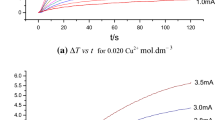Abstract
An analysis is made of the chemical heats liberated from a palladium-deuterium electrochemical cell operating inside a calorimeter. It is important, in such an analysis, to carefully identify the chemical and electrochemical sources of heat, before any “excess heats” can be ascribed to non-chemical reactions.(1) The calorimeter measures the enthalpy (ΔH r ) of the reaction; whereas, the electrochemical voltage of the cell reflects the free energy (ΔG r ) of the reaction within the Pd-D electrolysis cell. The heat energy from the calorimeter cell therefore doesnot equal the electrical energy supplied to the cell, as might initially be expected. The magnitudes of the differing calorimetric and electrochemical energies were found to be related through the “thermoneutral potential” (ξH) of the electrochemical reaction. The chemical heat theoretically expected from the calorimeter is given by (1) I(ξL-ξH), the cell current (I), multiplied by the difference between the operating cell voltage (ξL) and the thermoneutral potential (ξH), rather than (2) IξL, the electrical input power. This was verified empirically using a freon vaporization calorimeter, which operates on the principle of accurate measurement of the vaporization rate of liquid freon which completely surrounds the electrochemical cell. The calorimetrically-measured heats observed from a Pt/D2O, 0.1M LiOD/Pd electrochemical cell were within 2% of the thermoneutral potential predicted value, I(ξL-ξH); but were found to be 15–30% less than the electrical work supplied to the cell, IξL. Measurements of D2O consumed by the cell reactions also verified that essentially no significant recombination of D2 and O2 gases occurred within the cell. No “excess heats” were observed from this Pd cell during the 36 days of its electrolytic operation. Likewise, no increase in the neutron flux around the cell was found, using three3He radiation detectors.
Similar content being viewed by others
References
M. Fleischmann and S. Pons, and M. Hawkins, (1989).J Electroanal. Chem.,261, 301.
H. F. Gibbard (1978).J. Electrochem. Soc.,125, 353.
N. A. Godshall and J. R. Driscoll (1984).J. Electrochem. Soc.,131, 2221.
C. Wagner and W. Schottky, (1930).Z. Phys. Chem.,Bll, 163; (1933). B21, 25.
D. R. Lide, Jr., ed. (1982).J. Phys Chem. ll (Suppl. no. 2).
T. B. Flanagan (1961).J. Phys. Chem.,65, 280.
D. M. Nace and J. G. Aston (1957).J. Am Chem. Soc.,79, 3619.
D. M. Nace and J. G. Aston (1957).J. Am. Chem. Soc.,79, 3623.
D. M. Nace and J. G. Aston (1957).J. Am. Chem. Soc.,79, 3627.
S. Schuldiner and J. P. Hoare (1958).J. Electrochem. Soc.,105, 278.
R. I. Ewing, M. A. Butler, J. E. Schirber, and D. S. Ginley.Fusion Technol. (submitted).
Author information
Authors and Affiliations
Rights and permissions
About this article
Cite this article
Godshall, N.A., Roth, E.P., Kelly, M.J. et al. Calorimetric and thermodynamic analysis of palladium-deuterium electrochemical cells. J Fusion Energ 9, 229–237 (1990). https://doi.org/10.1007/BF02627590
Issue Date:
DOI: https://doi.org/10.1007/BF02627590




